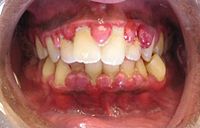
Photo from wikipedia
This study hypothesizes that the application of low‐dose nonthermal biocompatible dielectric barrier discharge plasma (DBD‐NBP) to human gingival fibroblasts (HGFs) will inhibit colony formation but not cell death and induce… Click to show full abstract
This study hypothesizes that the application of low‐dose nonthermal biocompatible dielectric barrier discharge plasma (DBD‐NBP) to human gingival fibroblasts (HGFs) will inhibit colony formation but not cell death and induce matrix metalloproteinase (MMP) expression, extracellular matrix (ECM) degradation, and subsequent cell migration, which can result in enhanced wound healing. HGFs treated with plasma for 3 min migrate to each other across the gap faster than those in the control and 5‐min treatment groups on days 1 and 3. The plasma‐treated HGFs show significantly high expression levels of the cell cycle arrest‐related p21 gene and enhanced MMP activity. Focal adhesion kinase (FAK) mediated attenuation of wound healing or actin cytoskeleton rearrangement, and plasma‐mediated reversal of this attenuation support the migratory effect of DBD‐NBP. Further, this work performs computer simulations to investigate the effect of oxidation on the stability and conformation of the catalytic kinase domain (KD) of FAK. It is found that the oxidation of highly reactive amino acids (AAs) Cys427, Met442, Cys559, Met571, Met617, and Met643 changes the conformation and increases the structural flexibility of the FAK protein and thus modulates its function and activity. Low‐dose DBD‐NBP‐induces host cell cycle arrest, ECM breakdown, and subsequent migration, thus contributing to the enhanced wound healing process.
Journal Title: Advanced Healthcare Materials
Year Published: 2022
Link to full text (if available)
Share on Social Media: Sign Up to like & get
recommendations!